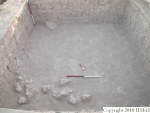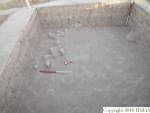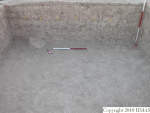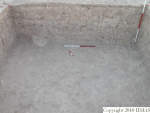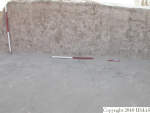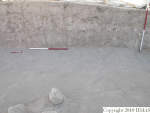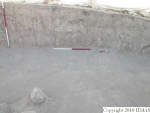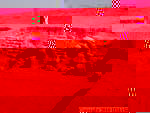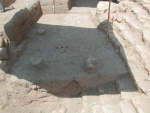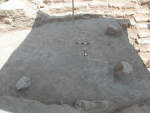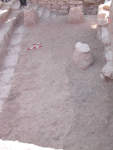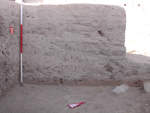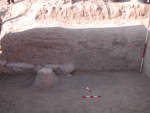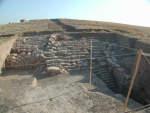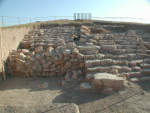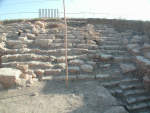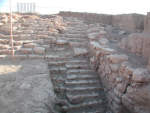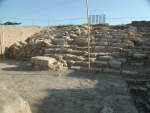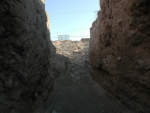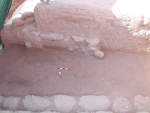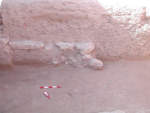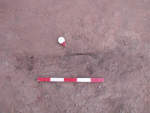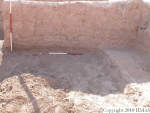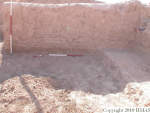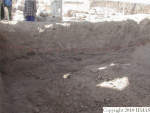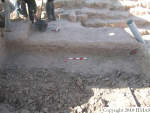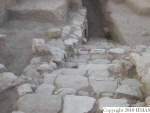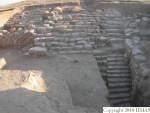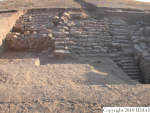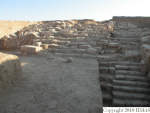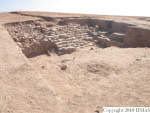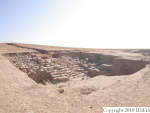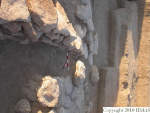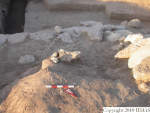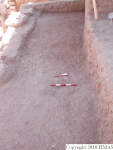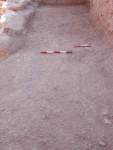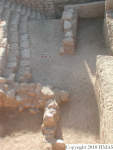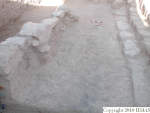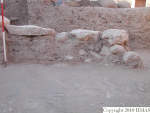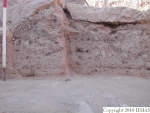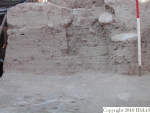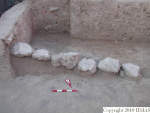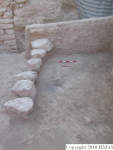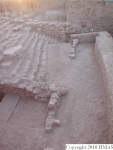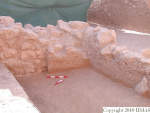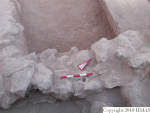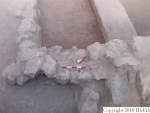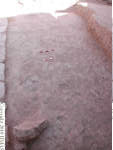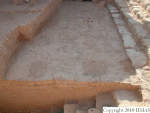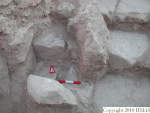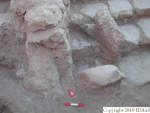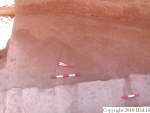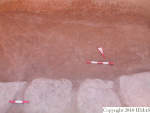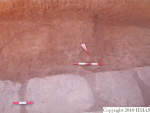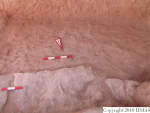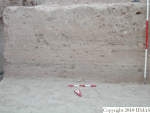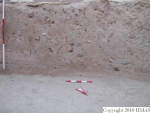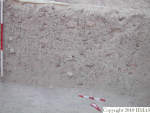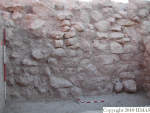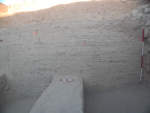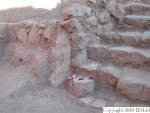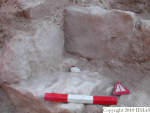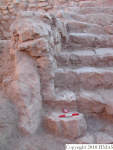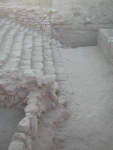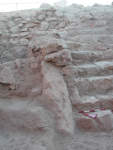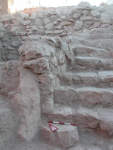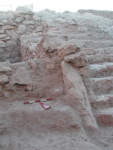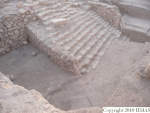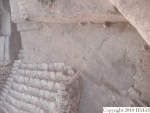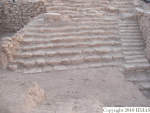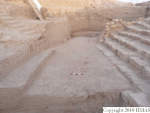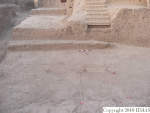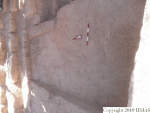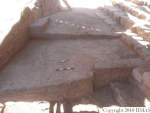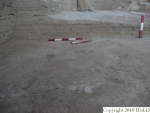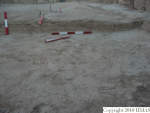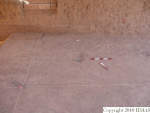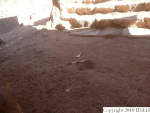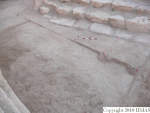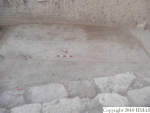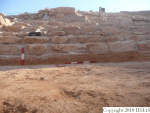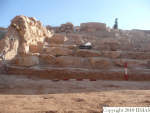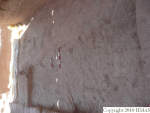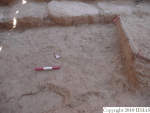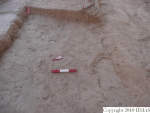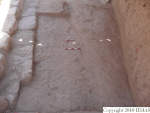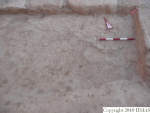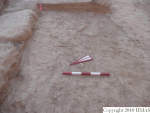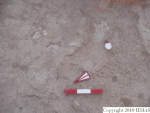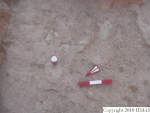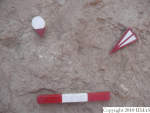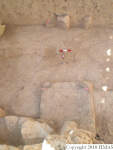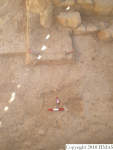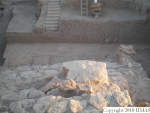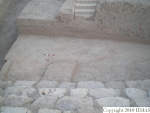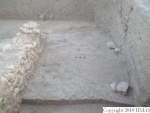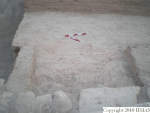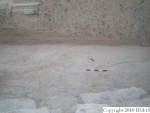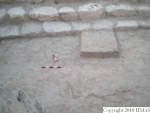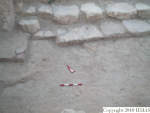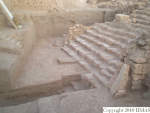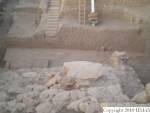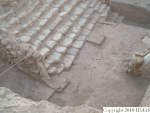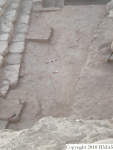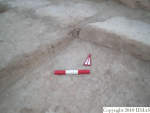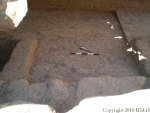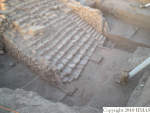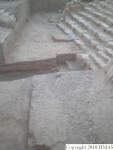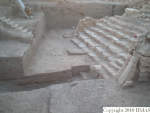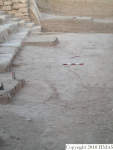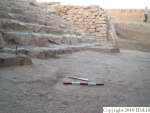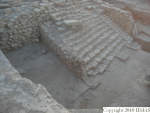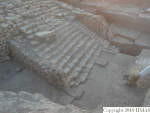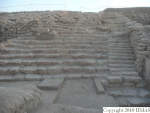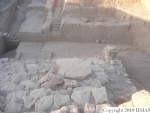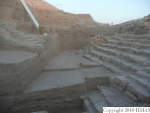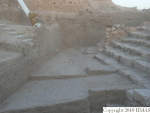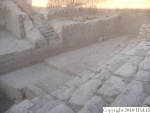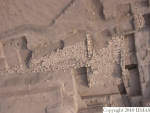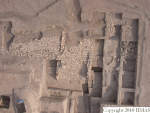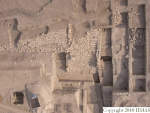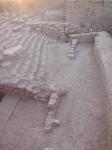1. OVERVIEW
| Roster | Date | Author | Record |
|---|---|---|---|
| Best image | 2014-10-24 | cJC |  [Input: YX24CJC.j] [Input: YX24CJC.j] |
2. IDENTIFICATION
Designation
| Roster | Date | Author | Record |
|---|---|---|---|
| Description (summary) | 2004-06-27 | mH | west of k100, north of k5 [Input: O627MH2.j] |
| 2008-03-07 | pC | k4 is a regular 5x5 meters regular locus. The northern baulk is cut by a german trench running East-West. It was opened to see the continuation of the apron f131. Is defined by the markers m3599, m3607, m3569, m3595, m3608, m3587 [Input: S206PC.j] | |
| 2009-08-22 | cJC | In MZ22 this locus was only partially excavated. The northern part of this locus contains the apron f131 while only about 1 meter extending south from the apron was excavated. It is defined in the south by m6150 and m6152. In the north the excavated area is bounded by the lowest visible step of the apron (f131) and markers m6154 and m6156. It's east baulk is defined by m6155 and m6151. [Input: T822CJC.j] |
3. STRATIGRAPHY
Recovery/Assignment
| Roster | Date | Author | Record |
|---|---|---|---|
| Daily notes about recovery of elements | 2004-06-28 | mH | We continued using the topsoil feature f3 for the first q-lot of the day q9 since we were still leveling the surface of the unit. After that I changed the feature into f5, layer below topsoil. I made this into a separate feature since it is located underneath a dark organic band, which represents a previous tell surface. f5 is hard and compacted with patches of softer soil where roots are or have been. It also contains small stones or pebbles. Thus far we have uncovered some pottery sherds and a few objects, which have mostly been figurine parts. [Input: O628MH.j] |
| 2004-06-28 | mH | z- Judging from the German trenches around k4 and k5 f5 will continue for quite some time and I expect to use this feature all through this week and possibly even longer. In the morning we did not have time to go very deep since I wanted to make sure first that we are level in the whole unit. Once that had been accomplished we continued going down in the whole locus with big picks. [Input: O628MH.j] | |
| 2004-06-29 | mH | We continued with big picks in this unit. So far we have not located any stones. At the end of the day we got the elevator working and I moved men of this unit to operate the elevator. [Input: O629MH3.j] | |
| 2004-06-30 | mH | The workmen assigned to this unit also work in k100 and thus they went between the two units all day and not a lot of progress was made here. Despite the fact that the soil matrix here did not change from yesterday I changed the feature here into f11 in order to keep better track of the q-lots. The soil matrix, however, is the same as in f5. [Input: O630MH.j] | |
| 2004-07-04 | mh | On Thursday we left the eastern half of the unit unexcavated. This half is east of the stones we discovered in the western half of unit towards the end of the day on Thursday. I continued that half with f11, which I have been using above in the whole unit. After this half was brought to the same level with the eastern half I changed the feature into f22 and defined it as lens type d. This feature is closely associated with the stones in this unit. The stones form a southeast-northwest running line in the southwest corner of the unit. I assigned these stones as f26 and defined it as lens type c. The stones are clearly the result of human activity but at the moment do not form a clear structure. In order to bring out the stones we worked first on the eastern half of the unit. This q-lot, q49, is included in f22 although no stones were found while excavating this q-lot. As in k5, the stones seem to be confined to the western half of the unit. We then excavated the western side of the unit under a different q-lot, q50. By the end of the day we had cleared soil around the stones and stopped the work on that level. [Input: O704MH.j] | |
| 2004-07-05 | mh | We took two photos of the unit with the stone feature f27 as the target. I also sketches them in on the plots I ran yesterday. We did not excavated here today. [Input: O705MH4.j] | |
| 2004-07-06 | mH | Sylvana drew the northern baulk of the unit. [Input: O706MH.j] | |
| 2004-07-08 | ap | we finished to remove the northern baulk between k4 and k5 (f39, q89 and q96) and we use the western baulk as a ramp for the wheelbarrow. [Input: O708AP.j] | |
| 2004-07-12 | ap | bM and eA, which joined us on the excavations yesterday, draw the long eastern section in k4 and k5. [Input: O712AP.j] | |
| 2004-07-25 | ap | we are going down in all the square, always removing the layer which was below the "Mittanic floor" . We started with the eastern half (f81, q248) and we went on with all the square (f81, q252 and q261). In the meantime we are removing also the eastern trench (f79, q251) which, more properly is the western side of the German trench, trying to reach the stones of the gateway. [Input: O726AP.j] | |
| 2004-07-26 | aP | we started going down in the feature previous excavated (f81, q263) until when we noticed the presence of a floor. This floor (f102, q269) is made by compact soil mixed with pebbles and with a few amount of sherds. It's, more or less, in the northern half of the square and it's possible to see it in the northern baulk. This pavement could belong to the Mittani period. We could flag the pottery and ask mkB to analyze it. Going down we reached a new layer (f105, q271 and q277) which is characterized by a very hard and compacted soil and extends itself in all the unit. In the meantime we are going down removing the eastern baulk of k4 (or, more correctly the western side of the German trench) (f79, q276) and we noticed the presence of a different layer. This feature (f110, q286) it's characterized by the presence of ash. [Input: O728AP.j] | |
| 2004-07-27 | aP | we are going down with the hard and compact layer (f105: q292 and q302) in all the unit. We also going on with the eastern baulk of k4 and k5 (properly the western side of the German trench) in f110 removing q293, q303, q311 and q313. After the drawing we also removed the northern baulk of the unit(f114, q308). [Input: O730AP.j] | |
| 2004-07-28 | aP | we started removing three meters from the northern baulk (f105, q322) but after we decided to reduce the excavating area at one meter (f105, q336) from the baulk. In the meantime we are going on removing the part outside the eastern baulk in k4/k5 (f110, q316) and removing the northern baulk of the unit (f114, q318 and q340). In the north-eastern corner, between the two baulks northern and eastern we noticed the same reddish kind of soil which was found in f101, k3: it's f119, q328. [Input: O730AP1.j] | |
| 2005-08-02 | mH | We are excavating only in the northern half of the unit. Last year, due to time and efficiency concerns, we did not excavate the southern half as deep as the northern half, which was level with k3 and k13. We continued our excavations in just those areas that were left lowest last year. As with k3 and k13 we fist removed the first 10 cm of the surface, which was contaminated. In the corner formed by the western baulk of k4 and the southern face of our excavated area, just about where r445 is located, someone had lit a fire during the winter. This fire had left marks on the sections. Below the contaiminated soil we stated with f139 and excavated one q lot q367. [Input: P802MH.j] | |
| 2005-08-03 | mH | In order to verify wheather we are indeed dealing with a slope we tried to follow them with a small pick (f141). The laminations did not seem to continue lower down except in patches. Whether these patches are natural, i.e. relating to a smaller water puddle, or the result of our removing the laminations only in parts and not others. The in the southwest corner of the unit the soil is granier, contains melted brick pieces, charcoal pieces, and pottery. Some of the workmen suggested that it might be a pit. We defined it as such for now with the provision that we will change the feature definition once we determine what it is (f143). As the last task of the day we started removing another 10 cm layer of soil (f141 q380) heading from the edge of k100 towards k13, i.e. east to west. The plan is to stop at the border of f143. [Input: P803MH.j] | |
| 2005-08-03 | mH | The first pick run of the day concentrated on the southern half. This was f139 q370. Next was f139 q372 when we removed approximately 10 cm soil in the western half of the joint k3 and k4, and the next is f139 q375 which refers to the eastern half of k3 and k4. These pick runs exposed an east-west oriented line of large stone blocks (f144). The western end of this stone alignment is close to but not quite at the edge of k4 and k100. At an approximately correponding place on the other side of k100 we have the "doorjam" belonging to f129. These could perhaps be related but we will have to see. vVE made an observation that the line of stones seems to be continued by bricks or at least bricky material. gB inspected the area and agreed that the material was indeed bricky but he hesitated calling them bricks due to lack of clear faces. He suggested scraping the area in order to see whether they indeed were bricks. After this was done, they disappeared, although the area approximately between r445 and m3956 does contain lumps of melted bricks. Instead of being a brick wall, the stone alingment seems to continue towards east. Underneath q-lots q372 and q375 we found laminations clearly visible in the shade that we put up after breakfast. These laminations were located in an area center and south of our k4. It is possible that we went through earlier lamination layers with the big pick and just did not notice them. These laminations seem to continue to k13 and they seem to slightly slope towards south. [Input: P803MH.j] | |
| 2005-08-06 | mH | Thursday we had removed soil from an area 50 cm wide (q386) along the apron (f131) in order to expose another step for the review on Saturday P805. Today we started by bringing the whole unit level (q386 and q389). We then cleaned the unit very well and took three pictures. v78 was of the floating stones (f147.1, f147.2, and f147.3), which we removed later together with their pedestals (f148 q390) and placed with stones removed last year. v79 shows the Western baulk k4 and v80 shows the southern baulk. We will cut these baulks further back tomorrow. We continued going down with the big pick (q391 and q392), but changed the feature into f149. This changes of feature did not result from a change in the characteristics of the soil, but from a concern of not letting features grow too thick. After the last big run of the day we found plenty of ash, charcoal and the small patches of the same reddish material that characterizes some areas of the palace and the packing of the upper parts of the temple terrace. Tomorrow we will give this a new feature number. [Input: P806MH2.j] | |
| 2005-08-07 | mH | Our intention today was to cut back the southern-most 1 m of k4 that had been left in place last year to due time constraints. However, because our back dirt pile located in k5 was very close to the edge of the southern border of k4, I dedided to go down in k4 while this back dirt was being removed. At the end of the day yesterday we had run into soil that contained ash, charcoal, reddish soil, and perhaps melted pieces of brick. We labeled that feature as f150. Today we started by excavating the first 10 cm of that feature (q393). We then continued with a second 10 cm pick run (q394). The last pile of dirt removed with the latter pick-run was included in q395, which might be contaminated by soil from steps (f131) closed to its edge. Beucase this feature was so clearly different from anything else we had discovered and because it is contained by f131 and capped by f144 and f151, we decided to flag q-lots q393 and q394 for mKB. She came to the field briefly after breakfast and took a look at one of the qlots. She found at least one Mittani sherd in the bag. She also suggested that we should ask vS whether she thinks it would be a good idea to take floating samples from this feature. Based on recommendations and instructions by vS we took three floating samples (q397, q398, and q399) from places where the ash and charcoal concentration was most pronounced. After taking the samples we started removing the last 1 m of soil from the southern portion of k4. We labeled this pseudobaulk as f152 and excavated q-lot q400. We relayed the large, flat stone (f154) overlaying f131 with the idea that it might be removed at some point. [Input: P807MH.j] | |
| 2005-08-08 | mH | We continued removing the pseudobaulk with feature f152 (q402 and q405). In section we could see that the soil matrix changed from a fine, sandy soil to a crumbly consistency. From the section it seems that the soil has packed into little balls of about 1-2 cm in diameter, which crumble very easily. This change was very difficult to see when excavating, but based on the section we changed the feature to f155 to reflect this change. [Input: P808MH.j] | |
| 2005-08-08 | sC | Today we dug only in the southern area of k4: this area is approximately 1m Sx6m WE and we treated it as a baulk. Here we finished digging f152, feature assigned yesterday to this limited area in k4, and we assigned a new feature number to the accumulation below, characterized by a compact surface and a soft and friable texture (f155). Two qlots have been collected during the excavation of f152 (q402 and q405). We dug also f155 for about 20 cm (one qlot has been collected during the exavation of the first 20 cm of f155, q406). Although we did not reach the bottom of this feature we decided to stop digging f155 in order to move the workmen into k5. After a meeting in the area with gB and fAB we decided to start digging in k5 in order to reach the same level there as feature f155 in k4, and at that point start to dig the southern area of k4 and either all, or only the northern area k5: we agree that throught the exposition of a larger area we will have a better understanding of the stratigraphy. [Input: P808SC2.j] | |
| 2005-08-16 | mH | We first started by bring the northern baulk of k5 down to level with the southern part of k4 (f181 q497, q501). We started labeling the northern baulk of k5 below the 90 m level as k4 since it is excavated together with the southern part of k4. We then continued down in this whole southern area of k4 (q507). Just in the area of the corner of northern and eastern baulk of k5 we found small pieces of broken bricks. [Input: P816MH.j] | |
| 2005-08-17 | mH | At the corner formed by the former east baulk and north baulk of k5 we found brown soil and pieces of brick. We defined this area as f188, whereas the gray and crumbly soil to its east was labeled as f189. We first excavated within f188 (q512) in order to examine whether the feature continues and perhaps reveals a structure in situ. After the first pick run it became evident that so such structure exits. We then excavated f189 (q513), which partly covers f144. [Input: P817MH.j] | |
| 2005-08-18 | mH | We continued with two features f189 in the west and f188 in the east. In feature f189 we excavated q521 and q531. In feature f188 we excavated q527. [Input: P820MH.j] | |
| 2005-08-20 | mH | We continued first in f189 (the western part, q534) and then went down in the eastern part (f188 q537). [Input: P820MH.j] | |
| 2005-08-20 | vVE | k4 is still excavated on its southern half only: south of stones f144. It still consists of the two different deposits f188 and f189. [Input: P820VVE1.j] | |
| 2005-08-23 | sC | Today we continued to dig in the southern area of k4 and to the north baulk of k5. The whole area was characterized by the presence of bricky material and by a brown-reddish coloration. We differenciated three feature numbers on the basis of the structure and consistence of the bricky material. In the north corner a layer characterized by a very fine consistence (due to the presence of melted bricks) has been differenciate (f216, it has been defined by r674, r675, r676) from the rest of the area, characherized by fragments of bricky materials of bigger dimension. f216 presents also some ashes area, element that suggest that this feature could be the same of f150 (in k3 and f171 in k13 and f174 in k101). We assigned two feature numbers to the southern area of k4, defining them through r677 (that has been located in the area where the transition between the bricky rubble and the bricky debris was more evident): f217 has been assigned to the south-weastern area of k4 from r677 (200m W and 200m S from r677) and f218 has been assigned to the south-eastern area of k4 (200m E and 200m S from r677). It has been very difficult to define the boundary between these two features (f217 and f218) because they present the same texture (very fine), consistence (medium soft) and color (brown-reddish coloration). We assigned f217 to the bricky rubble (on the eastern area of k4) and f128 to the bricky debris (on the weastern area of k4). We finished to dig f217, but we did not finished to remove f218 and f216. [Input: P823SC.j] | |
| 2005-08-24 | sC | Today we continued to dig in the southern area of k4 and to the north baulk of k5 where feature f218 and f216 were still present. We first finished to remove f218 (that we started excavating yesterday), then we remove f216, while bP took the relay of the wall f144. From the excavation of f216 we recovered only one pottery sherd (qlot579). [Input: P824SC.j] | |
| 2005-08-25 | sC | Today we did not exacavate in this area of J2; we took a picture of wall f232 (gv103, gv103a) and aL and AA relayed it (r718-r742). [Input: P825SC.j] | |
| 2005-08-29 | mH | This is the same as the elevation of f150 as we currently have it. After removing f232 and its pedestal f260, we started remving the pseudobaulk (f261), which I had left between k4 and k100 in order to prevent contamination between the two loci. At first we removed a large stone (f265), which was parallel to walls f144 and f232, and thus possibly part of the upper wall (f144). This stone is defined by relays r928 and r929. We did not finish removing f261 today. [Input: P830MH.j] | |
| 2005-08-29 | mH | We removed f232, the stone wall that was found below f144, another stone wall. This feature consisted of six stones, which we labeled as components of the feature. We then excavated the pedestal on which the wall stood. This is feature f260. The stones were highest in the east and sloped gradually to the west. The highest point in the east was m4082 +165-155 = 89.07 m, in the middle the elevation was m4082 +149-155 = 88.91 m, and in the west, at the lowest point, it was m4082 +121-155 = 88.63 m. [Input: P830MH.j] | |
| 2005-08-31 | mH | We continued down north of f224 with qlot q677, which is associated with q680 coming from the sifter. [Input: P831MH.j] | |
| 2005-08-31 | mH | We finished removing the last of f261 (q675), the pseudobaulk between k4 and k100. After that we started excavating in f150 starting along the steps of f131. We started from m4081 and moved first along approximately 2 m wide stretch along the steps (f150 q684). Then we excavated south of that q-lot all the way to the northern edge of k5. We ended the day by excavating along the western edge of k4 next to f127 (f150 q698). We removed f151, a stone floating on top of apron (f131) steps next to f127. [Input: P831MH.j] | |
| 2005-09-04 | sC | Today we continued to dig f286 in k4. Firstly we start by removing soil only in the south-eastern area of k4, which was left higer since yesterday (q729); then we continuing down in the whole unit (half an hour before breakfast). The work proceeded very slowly after breakfast since the elevator located in k5 was not working, and because the workmen had to remove the dirty using the little baskets. Therefore, in the second half of the morning the work in k4 has been basically of removing the dirty from the pickrun done in all the unit before breakfast. We also removed the little baulk left on the eastern area of k4, in order to avoid contamination in k 100 (to this baulk we have assigned a new feature number, f296, and the pottery has been collected in the q748). At the end of the morning we clean and scraped very well the whole area and expose a very nice and uniform surface, basically constituited by melted bricks (red and gray in colour). In the afternoon we called DAdin, we took a picture of the whole area, and then we start digging again. In the eastern area of k4 two pits have been noticed (r982, r983) quadrangolar in shape. Therefore, while another team of workmen was excavating in the western area of k4, we moved in the pit f298 Shallal, who dug f299 (the fill of the pit) and in f300 Shallal, who dug f301 (the fill of the pit). The fill of the pit is medium soft, a bit crumble, with ash areas and poor in pottery sherds. [Input: P903SC.j] | |
| 2005-09-05 | mH | on P904 the pit f300 was dug too deep. A metal artifact i25 was found, very similar and located close to i24; another pit to the West of the northern pit was found: the pitcut shape is round, and at the bottom was found gravel and seeds. Then was excavated f286. The pseudobaulk f261, very close to the North edge of k5,was removed [Input: S307PC.j] | |
| 2005-09-05 | sC | Today we continued to dig in k4 f150 in all the area. All the qlots collected in the first pickrun in the whole area area contaminated (q684, q692 and q698). We first dug in the NE area of k4 (q684), where f150 abuts the Apron (f131), then in the SE area of k4 (qlot6892, aproximately 2m N and 4mW to r942) and then in the W area of the unit (q698, aproximately 2m E and 4mS from r944). f150 presents almost the same characteristics in all the unit: it was characterized by a crumble texture, by a medium-soft consistence and by the presence of ash areas. After breakfast we dug in the weastern area of k4 (q684, q692). There is still an area to be excavated (1.5m N in corrispondence of the E baulk of k15): we will remove it tomorrow. Today f151 (a floating limestone) have been removed: it consist of just one big stone and not of two, as first thought (its irregular shape make us think that f151 consisted of two stones). In the pedestal (f271) of the stone f151 we did not collect any pottery sherd or bone. [Input: P831SC.j] | |
| 2005-09-05 | sC | We start by removing the ledge of soil that was left higer since yesterday (aproximately 2m N and 2m E, from r945 q701); this qlot is contaminated (the first 10 cm of the feature have been contaminated by the excavation held in k5 and k14 in the previous days). Then we change feature number: the whole area has been labeled as f286. f286 is the same of f150 but as a difference, f286 is not characterized by ashy areas, altough in all the surface can be noticed little fragments of charcoals. We dug f286 for an area wide aproximately 2m N and 2m E, from m4082 (q709) and a line of stones belonging to the Apron (f131) have been exposed. The first pickrun in this area produced a lot of dirt and the elevator -located in k5- broke early in the morning, therefore, the workmen took almost all the second half of the morning to remove the dirt from this little area (they removed the dirt by using little baskets). At the same time Shallal, Hussein and Akmet have been busy in exposing the step of the Apron "found" with the last pickrun of the morning. On three of these steps, 4 holes have been notices: we assigned a feature number to all of them (f278, f280, f282, f284; f279=q720, f281=q721, f283=q726, f285=q727): two of which seems to be natural, but two of them could be hand-made. The two hole that seems to be hand-made are aproximately 7cm in diameter; in their fill (f279=q720, f281=q721) have been found a stone that has same diameter of the cut of the hole, and for this reason we keep the stone as a q-item (q720.1 and q721.1); we collect also the soil contained in the fill of these holes as a q-item (q720.2, q721.2, q726.1 and q727.1) in order to be analized by vS. [Input: P901SC.j] | |
| 2005-09-06 | mH | Today we found several floor layers above the white floor (f326), all one on top of the other: expecially f328, f329 and f330 are very similar; we took a picture of the floors v132. We had difficulties exposing them, hence the pickman had to dig from various directions. at least there are 4 floors visible: f328, f327, f329, f330 [Input: S307PC.j] | |
| 2009-08-09 | cJC | Yesterday at the very end of the day we exposed several features which I described in yesterday's daily. Today we decided to continue removing f367 until we have only f369 and f359 showing. The small isolated plaster patches were assigned f370 and were relayed and photographed and then left in place. Once we removed f367 it became more apparent that f368 and f369 are likely the same as f369 seems to slope up and meet f358 under f367. I decided with fAB and pC that once we finished exposing f369 by removing f367 we should stop excavating temporarily in k4 and k5 and focus our efforts on reaching f359 in k15. Mohammed Kher removed all of f367 with only the small pick and the brush and so it took all day but we achieved a nice result. [Input: T809CJC.j] | |
| Strategy (projected or implemented) | 2004-06-29 | mH | We are still roughly 5 cm above the level where the stone was located in k5 today, but since the stone in k5 is probably isolated, I do not expect to find any large stones here any time soon. If the machine is working tomorrow, the men of this unit will operate the elevator in the morning and return to this unit after breakfast. We will continue with big picks the whole unit at a time. [Input: O629MH3.j] |
| 2004-06-30 | mH | Depending on the condition of the elevator, we will continue here with a big pick. At the end of the day today we were roughly 50 cm above today's ending level of k5, where there is clearly something going on. Tomorrow we will try to reach this level. [Input: O630MH.j] | |
| 2004-07-01 | mh | Since the crew in k4 has been moving between k100 and k4, the excavation have not yet reached as deep a level as in k4 and k5. Judging from the presence of stones in k4 and k5, I expected to find similar stones in this square as well. Right at the end of the day we did indeed find similar sized stones in this unit as well. They are, however higher up than in k14 and k5. [Input: O703MH3.j] | |
| 2004-07-01 | mh | We will continue uncovering the stones with care paying special attention to the possibly of a floor being present. I continued using f11 all day today. While the nature of the soil was not different above the stones (q38) I am contemplating whether to make a new feature "accumulation over stones" starting from this q-lot. I will determine it on Sunday when the whole unit has been excavated. [Input: O703MH3.j] | |
| 2004-07-04 | mh | Work stopped here for a while. [Input: O704MH.j] | |
| 2004-07-06 | mH | We will take the northern baulk down tomorrow to connect k5, k4, and k14. [Input: O706MH.j] | |
| 2005-08-07 | mH | At the moment the ashy layers of f150 seem to be capped by the line or wall of stones (f144) and a group of smaller stones (f151) near the NW corner of k4. One of the purposes for removing the pseudobaulk (f152) is to see how f144 relates to the apron f131, to the stone feature f154, and to the soil feature f150. We hope to accomplish this tomorrow. [Input: P807MH.j] | |
| 2005-08-08 | mH | We stopped excavating approximately 30 cm above the highest stone belonging to f144 in order to wait for k5 to be brought to the same level before continuing further down. The goal with this is to understand the nature of f144, its possible relationship with door jamb in f129 and with f150. We can achieve this goal better if we approach the feature from above with a larger horizontal exposure than would have been possible if we just continued excavating the 1 m wide pseudobaulk. [Input: P808MH.j] | |
| 2005-08-16 | mH | We are getting close to stone feature f144. From the section it seems that there is a layer of bricks just above them during their whole length. This layer of bricks then seems to slope down towards west after the stones end. Tomorrow we have to pay close attention to the surface in order to detect these possible brick. [Input: P816MH.j] | |
| 2005-08-17 | mH | Tomorrow we will continue excavating these two features (f188 and f189) in search for a possible structure to which the bricks belong. [Input: P817MH.j] | |
| 2005-08-24 | sC | yesterday mH, fAB, jO and I talked in the field about the nature of f144. We were thinking that f144 was a wall on the top of an accumulation. We were not expecting that this accumulation would have hidden another wall. The plan for today was to remove f144 (looking for a possinle different phase in the accumulation under f144) and then start digging in f150, close to the Apron (f131) in order to expose more steps. Therefore, after a discussion in the field with fAB and jO, we decided to change strategy: we will leave for today f232 in place, and tomorrow we will take a picture of all the area; then we will remove the wall f232. At the end of the morning, FAB, gB and jO came in J2: we discuss, togheter with aL, about the strategy for tomorrow, especially about how to make the section in k14. We agree that we need more workmen, that should arrive tomorrow, in order to oper k24 while go down in k15 and k14. [Input: P824SC.j] | |
| Argument | 2005-08-07 | mH | The ashy, red accumulation f150 in front of the steps of the apron f131 could perhaps be associated with and related to the same activities that the large, flat stone f154 was used. gB and mKB suggested that the f154 could perhaps be an offering stone and perhaps f150 shows the use this area was put to while the stone (f154) was used. [Input: P807MH.j] |
| 2005-08-08 | mH | f155 slopes towards the east and I suspect it is due to stone features f151 and f144, which delineate the SW corner in front of the pseudobaulk. It is possible that these stones contained material between them and the apron f131, and hence the process of accumulation was different to the north and south of these stones. It seems that to the north the accumulation was faster and hence a slope formed to the south and south-west of stone features f144 and f151. I suspect that f143, which we at first thought might have been a pit, also formed as a result of these stones. f143 was located higher up in this corner than the stones, but their presence affected the accumulation process also higher up. [Input: P808MH.j] | |
| 2005-08-17 | mH | From the section we could see that just above f144 there were a few bricks which, after the stone feature ends, slope towards the east and then continues horizontally. They were very difficult to notice when approaching from above and they do not seem to form an easily detectable structure. Perhaps it was destroyed in antiquity. [Input: P817MH.j] | |
| 2005-08-18 | mH | fAB visited our unit in the morning and explained the terminology applicable to various stages of brick collapse. This they had come up with in A16 a few years back. According to this terminology brick melt is a deposit where one cannot recognize individual bricks, but it is clear that the soil matrix does consist of bricky material. This is the last stage of brick decomposition. Brick crumble is material in which melting is not yet complete and brick crumples are visible. The first stage in the sequence is brick fall where individual pieces of bricks can be disserned. According to this terminology, our feature f188 located in the easter part of k4 is brick melt, whereas f189 in the west is brick crumble. Right on top of the stone feature f144 we have one line of brick extending from east to west, sloping down and east after the stones end and continuing east. This, I suspect, is then brick fall. The direction of the brick deposits seems to indicate a collapse from east to west. Perhaps this brick fall is related to the bricks seen next to f129 (door jamb) in the eastern section of k100. [Input: P820MH.j] | |
| 2005-08-24 | sC | I decided to characterize and assigne a different feature number for the accumulation between the stones (f226) and for the accumulation under the stones (f230) of wall f144 because of their different consistence. I tought it could have been useful in the case the analisys of the pottery would have given a intresting datation. A layer of ash was in fact noticed in the pedestal of f144, and mH and I thought that it could have been a marker/indicator of a possible different phases in the accumulation under f144. [Input: P824SC.j] | |
| 2005-08-24 | sC | f216 seems to be the same accomulation under the wall f232 (the wall under wall f144): it is very compact and it is bricky melted in texture and consistence. We took a picture of the section of wall f144 (gv99, gv99a, gv99b) and we remove wall f144. I assigned f226 to the soil contained between the stones of f144 (the soil between the top and the bottom elevation of the stones of the wall): f226 present a loose texture, very easy to remove. Under f144 another wall have been exposed, separated to f144 by an accumulation thick aproximately 15-30cm. I assigned a new feature number to this accumulation (f230). f230 it is similar to f226 in texture (very fine, and clayish) but very different in consistence (f226 is very easy to remove while f230 is more compact). Once excavated f230, another lines of 7 big stones (f232) have been exposed. [Input: P824SC.j] | |
| Formal inconsistencies | 2009-08-26 | cJC | After plotting the J2 loci from MZ22 it became apparent that they do not exactly match the squares of the previous years. This is not totally unexpected as we had many problems at the beginning of the season trying to reestablish the squares due to the small number remaining markers in J2 as well as the depth of J2 compared to the remaining markers. The differences are not substantial but should be noted. [Input: T826CJC.j] |
Volumetric Localization
| Roster | Date | Author | Record |
|---|---|---|---|
| Elements within locus | 2007-07-18 | pC | a5 (installation) a6 (installation) a7 (structure) a9 (pit) a10 (pit) [Input: S206PC2.j] |
| 2004-06-30 | mh | f3 (topsoil) f5 (layer) [Input: O630MH3.j] |
|
| 2004-06-29 | mH | f11 (layer) [Input: O705MH.j] | |
| 2004-07-04 | mH | f22 (lens type d) f27 (lens type c) f28 (isolated stone) [Input: O807AP5.j] |
|
| 2004-07-07 | mH | f39 (mix feature) [Input: O807AP5.j] | |
| 2007-07-20 | sC | f79 (mix feature) f81 (lens type d) [Input: S131PC2.j] |
|
| 2004-07-26 | ap | f102 (floorsurface in general) f105 (lens type d) f110 (lens type d) [Input: O808AP3.j] |
|
| 2004-07-27 | ap | f114 (lens type d) f119 (lens type d) [Input: O808AP3.j] |
|
| 2005-08-02 | sC | f135 (accumulation D) [Input: P803AL2.j] | |
| 2005-08-02 | vVE | f139 (accumulation D) [Input: P912MH.j] | |
| 2005-08-03 | vVE | f141 (lens type d) f143 (accumulation D) f144 (wall) [Input: P912MH.j] |
|
| 2005-08-04 | sC | f145 (accumulation D) [Input: P912MH.j] | |
| 2005-08-06 | sC | f147 (isolated stone) f148 (lens type d) [Input: P912MH.j] |
|
| 2005-08-06 | mH | f149 (accumulation D) [Input: P912MH.j] | |
| 2005-08-07 | sC | f150 (accumulation B) f151 (isolated stone) f152 (accumulation D) [Input: P912MH.j] |
|
| 2005-08-08 | sC | f155 (accumulation D) [Input: P912MH.j] | |
| 2005-08-16 | sC | f181 (lens type d) [Input: P912MH.j] | |
| 2005-08-17 | sC | f188 (accumulation) f189 (accumulation) [Input: P912MH.j] |
|
| 2005-08-22 | vVE | f207 (accumulation D) f208 (accumulation D) [Input: P913MH.j] |
|
| 2005-08-23 | mH | f216 (brickfall) [Input: P913MH.j] | |
| 2005-08-23 | sC | f217 (brickfall) f218 (accumulation D) f226 (accumulation D) f230 (accumulation D) f232 (wall) [Input: P913MH.j] |
|
| 2008-03-07 | pC | f257 (stone installation) [Input: S206PC.j] | |
| 2005-08-27 | mH | f260 (lens type d) [Input: P913MH.j] | |
| 2005-08-27 | aL | f261 (accumulation D) [Input: P913MH.j] | |
| 2005-08-29 | aL | f265 (isolated stone) [Input: P913MH.j] | |
| 2005-08-31 | sC | f271 (accumulation D) [Input: P913MH.j] | |
| 2005-09-01 | sC | f278 (hole) f279 (fill) f280 (hole) f281 (fill) f282 (hole) f283 (fill) f284 (hole) f285 (fill) f286 (accumulation D) [Input: P913MH.j] |
|
| 2005-09-03 | sC | f296 (accumulation D) [Input: P913MH5.j] | |
| 2005-09-03 | mH | f298 (pit-c) f299 (fill) f300 (pit) f301 (fill) [Input: P913MH5.j] |
|
| 2005-09-04 | aL | f310 (layer) [Input: P913MH5.j] | |
| 2005-09-05 | aL | f311 (pit-c) f312 (fill) f315 (accumulation D) [Input: P913MH5.j] |
|
| 2005-09-05 | sC | f316 (accumulation D) [Input: P913MH5.j] | |
| 2005-09-05 | aL | f317 (isolated stone) f318 (lens type d) [Input: P913MH5.j] |
|
| 2005-09-05 | sC | f322 (accumulation D) [Input: P913MH5.j] | |
| 2005-09-05 | aL | f324 (accumulation B) [Input: P913MH5.j] | |
| 2005-09-06 | mH | f326 (floor, type a) f327 (floor, type d) f328 (floor, type d) f329 (floor, type d) f330 (floor, type d) [Input: P913MH5.j] |
|
| 2005-09-13 | mH | f332 (floor, type b) [Input: P913MH5.j] | |
| 2009-07-25 | cJC | f339 (floor, type b) [Input: T822CJC2.j] | |
| 2009-08-19 | cJC | f365 (floor, type d) [Input: T819CJC2.j] | |
| 2009-08-06 | cJC | f367 (lens) f368 (floorsurface in general) [Input: T822CJC2.j] |
|
| 2009-08-09 | cJC | f370 (floor, type a) [Input: T822CJC2.j] | |
| 2010-08-25 | yM | i1 (unknown) [Input: U906YM.j] | |
| 2005-08-18 | sC | i11 (unknown) [Input: P913MH4.j] | |
| 2005-08-29 | aL | i24 (unknown) i25 (arrow) [Input: P913MH4.j] |
|
| 2004-06-27 | mH | q7 (pottery) [Input: O627MH3.j] | |
| 2004-06-28 | mh | q9 (items, pottery) q11 (items, pottery) q13 (pottery) [Input: O628MH2.j] |
|
| 2004-06-29 | mh | q14 (pottery) q17 (items, pottery) [Input: O629MH.j] |
|
| 2004-06-30 | mh | q27 (items, pottery) [Input: O630MH2.j] | |
| 2004-07-01 | mh | q33 (pottery) q38 (pottery) [Input: O703MH.j] |
|
| 2004-07-04 | mh | q43 (pottery) q47 (pottery) q50 (pottery) [Input: O705MH2.j] |
|
| 2004-07-07 | ap | q84 (pottery) [Input: O710MH.j] | |
| 2004-07-08 | ap | q89 (bones, items, pottery) q96 (pottery) [Input: O710MH.j] |
|
| 2004-07-21 | ap | q223 (pottery) [Input: O721AP2.j] | |
| 2004-07-22 | mh | q229 (bones, items, pottery) q237 (items, pottery) [Input: O724MH.j] |
|
| 2004-07-25 | mH | q248 (bones, pottery) q251 (pottery) q252 (pottery) q261 (pottery) [Input: O726AP1.j] |
|
| 2004-07-24 | mH | q263 (pottery) q269 (pottery) q271 (bones, pottery) q276 (pottery) q277 (pottery) q286 (pottery) q292 (bones, pottery) q293 (pottery) q302 (pottery) q303 (pottery) q308 (pottery) q311 (pottery) q313 (pottery) q316 (pottery) q318 (pottery) q322 (bones, pottery) q328 (pottery) q336 (pottery) q340 (pottery) q344 (bones, pottery) q347 (pottery) q348 (bones, pottery) q351 (bones, pottery) q356 (bones, pottery) [Input: O726AP1.j] |
|
| 2005-08-03 | vvE | q367 (bones, items, pottery) q370 (bones, items, pottery) q372 (bones, items, pottery) q375 (bones, items, pottery) q377 (bones, pottery) q380 (bones, pottery) [Input: P803AL3.j] |
|
| 2005-08-03 | vVE | q381 [Input: X925CJC.j] | |
| 2005-08-04 | mH | q383 (bones, pottery) [Input: V910CJC.j] | |
| 2005-08-04 | aL | q385 (bones, pottery) q386 (pottery) [Input: U808YM3.j] |
|
| 2005-08-06 | aL | q387 (bones, pottery) [Input: U808YM3.j] | |
| 2005-08-06 | sC | q388 (bones, pottery) [Input: V910CJC.j] | |
| 2005-08-06 | aL | q389 (pottery) [Input: U808YM3.j] | |
| 2005-08-06 | sC | q390 (pottery) [Input: U808YM3.j] | |
| 2005-08-06 | mH | q391 (pottery) [Input: U808YM3.j] | |
| 2005-08-06 | sC | q392 (bones, items, pottery) [Input: U808YM3.j] | |
| 2005-08-07 | sC | q393 (bones, items, pottery) q394 (bones, items, pottery) q395 (bones, items, pottery) q397 (items) q398 (items) q399 (items) [Input: P808VVE1.j] |
|
| 2014-01-17 | cJC | q400 (bones, items, pottery) [Input: Y117CJC.j] | |
| 2005-08-08 | sC | q402 (bones, items, pottery) [Input: P808VVE1.j] | |
| 2014-01-17 | cJC | q405 (items, pottery) q406 (items, pottery) [Input: Y117CJC.j] |
|
| 2005-08-16 | sC | q497 (bones, pottery) q501 (pottery) q507 (pottery) [Input: P909MH.j] |
|
| 2005-08-17 | sC | q512 (bones, pottery) q513 (bones, pottery) [Input: P909MH.j] |
|
| 2005-08-18 | vVE | q521 (bones, pottery) q527 (bones, pottery) q531 (bones, pottery) [Input: P908MH2.j] |
|
| 2005-08-20 | vVE | q534 (bones, pottery) q537 (bones, pottery) q540 (bones, pottery) q541 (bones, pottery) [Input: P908MH2.j] |
|
| 2005-08-21 | vVE | q547 (pottery) q548 (bones, pottery) [Input: P908MH2.j] |
|
| 2005-08-22 | vVE | q558 (pottery) [Input: P908MH2.j] | |
| 2005-08-23 | sC | q564 (bones, pottery) q570 (pottery) [Input: P908MH2.j] |
|
| 2005-08-24 | sC | q574 (pottery) q579 (pottery) q582 (pottery) q583 (pottery) q586 (bones, pottery) [Input: P908MH2.j] |
|
| 2005-08-28 | aA | q666 (pottery) [Input: P908MH2.j] | |
| 2005-08-29 | mH | q671 (bones, pottery) [Input: P910MH.j] | |
| 2005-08-31 | aL | q675 (pottery) [Input: P910MH.j] | |
| 2005-08-31 | mH | q684 (pottery) [Input: P910MH.j] | |
| 2005-08-31 | sC | q692 (bones, pottery) q698 (pottery) [Input: P910MH.j] |
|
| 2005-09-01 | mH | q701 (pottery) [Input: P910MH.j] | |
| 2005-09-01 | sC | q709 (bones, pottery) q720 (bones, items) q721 (items) q726 (items) q727 (items) [Input: P910MH3.j] |
|
| 2005-09-03 | mH | q729 (pottery) [Input: P910MH3.j] | |
| 2005-09-03 | aL | q739 (pottery) [Input: P910MH3.j] | |
| 2005-09-03 | sC | q748 (pottery) [Input: P910MH3.j] | |
| 2005-09-03 | mH | q750 (bones, items, pottery) q751 (bones, items, pottery) [Input: P910MH3.j] |
|
| 2005-09-03 | aL | q752 (bones, pottery) [Input: P910MH3.j] | |
| 2005-09-04 | mH | q755 (pottery) q760 (bones, items, pottery) q761 (items, pottery) [Input: P910MH3.j] |
|
| 2005-09-04 | aL | q763 (bones, pottery) q770 (pottery) [Input: P910MH3.j] |
|
| 2005-09-04 | mH | q771 (items, pottery) [Input: P910MH3.j] | |
| 2014-01-17 | cJC | q773 (pottery) [Input: X925CJC.j] | |
| 2005-09-05 | sC | q774 (bones, pottery) q777 (bones, pottery) [Input: P910MH3.j] |
|
| 2005-09-05 | aL | q779 (bones, pottery) q790 (pottery) q793 (bones, pottery) q795 (pottery) q797 (pottery) [Input: P910MH3.j] |
|
| 2005-09-05 | sC | q799 (bones, pottery) [Input: P910MH3.j] | |
| 2005-09-05 | aL | q803 (bones, pottery) [Input: P910MH3.j] | |
| 2005-09-06 | sC | q806 (bones, pottery) q809 (pottery) q813 (pottery) [Input: P910MH3.j] |
|
| 2005-09-06 | aL | q816 (pottery) q818 (bones, pottery) [Input: P910MH3.j] |
|
| 2005-09-06 | mH | q821 (bones, items, pottery) [Input: P910MH3.j] | |
| 2009-08-07 | cJC | q878 (pottery) q879 (bones, pottery) [Input: T826CJC2.j] |
|
| 2009-08-09 | sH | q880 (pottery) [Input: T826CJC2.j] | |
| Relays (applicable to elements) | 2005-09-04 | aL | r991 (39080 50361 - 4027 / Relay location: p) [Input: S306PC-R.j] |
| Extension of locus or q-lot | 2004-06-27 | mH | m3595 [Input: O627MH2.j] |
| Length of two sides | 2004-06-27 | mH | 400e [Input: O627MH2.j] |
| 2004-06-27 | mH | 400n [Input: O627MH2.j] |
